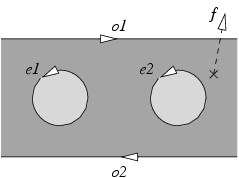Consider a Seifert fibred space over some base orbifold, containing one or more exceptional fibres and optionally one or more boundary components. Here we describe the notation used for the exceptional fibres, as well as their relationship to curves on the boundary components.
Consider the illustration below. Here the base orbifold is an annulus, with boundary components at the top and bottom of the diagram. The two circles in the middle correspond to two exceptional fibres.

The boundary curves o1 and o2, as well as the curves e1 and e2 bounding the exceptional fibres, can be given consistent orientations as illustrated by the arrows. The fibres can also be consistently oriented; let them be parallel copies of some curve f.
Suppose that we describe the space as having exceptional fibres with parameters (p1, q1) and (p2, q2). This corresponds to removing all fibres inside curves e1 and e2, and filling the resulting boundaries with solid tori whose meridinal curves are (p1 * e1 + q1 * f) and (p2 * e2 + q2 * f).
An obstruction constant of b is treated as an additional exceptional fibre with parameters (1, b) according to the description above.
Where necessary, we use the oriented curves o1 and o2 as curves on the boundaries "representing the base orbifold", and parallel copies of f as curves on the boundaries "representing the fibres". This becomes particularly important when joining different boundary components together.
It is worth noting the following observation. Suppose we have a Seifert fibred space with boundary, and let one of its boundary components have oriented curves (f, o) representing the fibres and base orbifold respectively. Then exactly the same space can be written with an additional (1,1) fibre (i.e., the obstruction constant b is incremented by one), with the effect that the curves on that boundary representing the fibres and base orbifold become (f, o + f) instead.